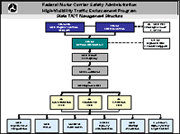|
Background
Crash data compiled by the National Highway Traffic Safety Administration indicates that the truck-involved fatality rate on the nation's roadways declined 12% in 2008 compared with 2007, with the number of truck-related crash fatalities dropping from 4,822 in 2007 to 4,229 in 2008. Initiatives such as TACT are helping to decrease the fatality rate by making the general driving public more aware of the safe ways to interact with trucks and provide large vehicles with more room and maneuverability. To help reduce crashes and fatalities further, the Federal Motor Carrier Safety Administration (FMCSA) is working to educate motorists on how to share the road safely with commercial motor vehicles (CMVs).
The Ticketing Aggressive Cars and Trucks (TACT) program is a high—visibility traffic enforcement program that uses communication, enforcement, and evaluation activities to reduce CMV-related crashes, fatalities, and injuries.
In the fall of 2004, Washington was selected as the first pilot State for the TACT program. Based on the success of the Washington State TACT program and other traffic enforcement programs such as Click It or Ticket, FMCSA encouraged additional States to undertake TACT programs on roadways with injuries and fatalities resulting from crashes between cars and trucks. Currently there are fifteen States participating in the TACT program.
Purpose
TACT provides a research-based safety model that can be replicated by States when conducting a high-visibility traffic enforcement program to promote safe driving behaviors among car and truck drivers.
Mission
The mission of the TACT program is to reduce CMV-related crashes, injuries, and fatalities. FMCSA is achieving its mission by educating car and truck drivers on how to share the road safely.
Strategy
The TACT program combines communication and evaluation with targeted enforcement activities to raise awareness among car and truck drivers about safe driving behaviors. Unsafe driving behaviors may include, but are not limited to: unsafe lane changes, tailgating, failing to signal lane changes, failing to yield the right of way, speeding, and aggressive driving (a combination of two or more behaviors). Pre-planning activities for States include problem identification and goal setting. Outreach and education activities are supported by a communications plan that includes print or Web-based outreach and paid or earned media placement. Evaluation of the reduction in crashes following a TACT enforcement period is followed by post-program activities such as reporting and recognition and rewards programs.
Structure
To ensure success, it is important to secure the skills and expertise of law enforcement, communications specialists, evaluators, and key State, local, and industry partners. It is also critical that sufficient resources be allocated for the program to be able to communicate the correct message to the target audience and ensure the commitment of law enforcement to the program.
FMCSA has provided a sample management structure for States to refer to when planning to implement a high-visibility traffic enforcement program. The structure illustrates the relationships between Federal, State, and local partners who, by working together, can successfully implement a TACT program. Click on the Sample Management Structure below to view a full-size version.

|